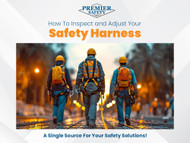How To Inspect and Adjust Your Safety Harness
Posted by Michael Womack - Premier Safety on Apr 30th 2024

High-altitude tasks in industries such as construction, window cleaning, and telecommunications inherently carry significant risks. A critical component that mitigates these risks is the safety harness—a lifeline for workers suspended above the ground. However, the effectiveness of a safety harness is heavily dependent on its condition and proper adjustment. Therefore, knowing how to meticulously inspect your safety harness is not just a procedure; it’s a safeguard against potential falls that could have dire consequences.
In this detailed guide, we will walk you through each step of inspecting your safety harness, ensuring that it meets the stringent safety standards required for your high-risk work environment. Follow these steps to guarantee your gear is in top-notch condition, ready to protect you day after day.
How to Inspect Your Safety Harness
Check for Visible Damage
Begin your inspection by searching for any visible impairments. Look for cuts, burns, fraying, or chemical damage on the harness material. Such damage can critically undermine the harness's integrity during use, increasing the likelihood of failure when it's needed most.
Inspect Straps and Buckles
Scrutinize all straps for signs of wear and tear, especially in areas subjected to higher loads. Ensure that buckles are not cracked, bent, or warped, and that they fasten securely without slippage. Maintaining strap adjustability and buckle integrity is crucial for the proper fit of the harness.
Verify Integrity of Attachment Points
Attachment points are critical to the performance of safety harnesses. Inspect each D-ring and other metal components for distortion, cracks, breaks, or excessive wear. These elements should be robust and free from sharp edges that could snag straps or cables.
Check Stitching and Connection Points
Ensure that all stitching is intact and not showing signs of wear or damage. Examine the connection points where straps meet buckles and D-rings. These connections must be secure without any loose threads or separations.
Assess Wear and Tear on Webbing
Inspect the webbing for pilling, stretching, or thinning. Look for discoloration, which may indicate UV damage or exposure to harmful chemicals. Continuous exposure can weaken the webbing, compromising the harness’s effectiveness.
Confirm Label Legibility and Compliance
Check that all labels on the harness are legible. These labels provide essential information, including the model number, manufacturing date, and compliance marks, which are crucial for adhering to "OSHA harness inspection" standards.
How to Put On Your Safety Harness Correctly
Properly wearing a safety harness is essential for protection during high-altitude tasks. Follow these summarized steps to ensure your harness is adjusted correctly for safety and comfort:
1. Hold and Shake the Harness: Begin by holding the harness by the dorsal D-ring and give it a shake to untangle the straps.
2. Inspect Before Wearing: Perform a quick visual check for any damage or twisted straps before putting on the harness.
3. Put on the Harness: Slip your arms through the shoulder straps, ensuring the D-ring is centered just below the neck and that straps lie flat without twists.
4. Connect the Chest Strap: Fasten the chest strap across the middle of your chest, adjusting it to be snug but not restrictive to breathing.
5. Adjust the Leg Straps: Insert legs through the loops, buckle up, and tighten until snug, ensuring you can still slide your hand between the strap and your leg.
6. Final Adjustments: Walk around to check the harness’s fit and comfort. Make any necessary strap adjustments to avoid pinching or binding.
7. Buddy Check: Have a colleague perform a final inspection to confirm that the harness is correctly fitted, and all connections are secure.
Ensuring Proper Harness Adjustment:
1. Check Tightness: The harness should fit snugly, allowing only a flat hand, not a closed fist, between the strap and your body.
2. Ensure Symmetry: Adjust all straps to equal tension for even force distribution.
3. Verify Free Movement: Ensure you can move freely without restriction to confirm a proper fit.
Following these steps and checks helps secure your safety by ensuring the harness is worn correctly, tailored to provide maximum protection while maintaining mobility in high-risk environments. Always consult the manufacturer’s guidelines for specific safety instructions related to your harness model.
FAQs:
How Do You Check a Harness?
Regular inspection of each part of the harness, as outlined above, should be an integral part of your safety protocol, especially concerning fall protection harness inspection.
Can I Inspect My Harness?
Yes, it is advisable for workers to inspect their own harnesses before each use to ensure maximum safety.
How Do You Properly Use a Harness?
Always ensure the harness fits snugly and comfortably, with all buckles and straps secured and correctly adjusted. Follow the manufacturer's instructions for optimal results.
How Should You Adjust Your Body Harness for the Best Fit?
Adjust all straps to fit your body comfortably. The harness should allow free movement but remain tight enough to prevent falls.
How Do You Check a Harness for Safety?
Perform regular inspections as detailed in this article, focusing on "fall harness inspection" and checking for wear, damage, and functionality.
How Often Do You Test a Harness?
OSHA recommends inspecting the harness before each use. More thorough inspections should be conducted according to the manufacturer's recommendations and depending on the frequency of use.
Securing Safety: Final Thoughts on Harness Inspection and Adjustment
Regular inspection and proper adjustment of your safety harness are critical to ensuring safety in high-altitude work environments. Adhering to these guidelines not only keeps you compliant with "OSHA harness inspection" requirements but also secures the well-being of all on-site personnel.
At Premier Safety, we are committed to providing you with the tools and information needed to maintain safety standards. For more details or to inquire about our safety solutions, contact us today. Together, let's ensure your workplace is safe and compliant.
Shop for Premier Fall Protection Rescue Equipment today with Premier Safety.

